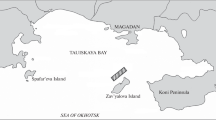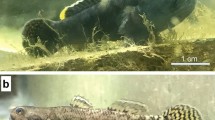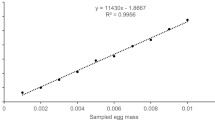Abstract
The spawns and the embryonic development of the nudibranch species Polycera aurantiomarginata (García and Bobo in Cah Biol Mar 25:361–373, 1984) and Polycera quadrilineata (Müller, 1776) were studied for two years. Throughout this study some abnormalities were detected in the embryonic and larval development of both species. First, the spawn seemed a pearl necklace because the eggs did not have intracapsular liquid and the capsular wall appeared very close to the egg. Second, embryos showed a normal development until the gastrula stage then a transparent sphere with two opposite cilia tuffs was developed instead the normal veliger larva. Third, aberrant veliger larvae were detected, in P. quadrilineata some of them showed a black zone. In P. aurantiomarginata the teratological events could be related to adult size and spawn number. Animals smaller than 15 mm never laid viable spawns while the egg masses of adults with 16–25 mm in size showed abnormalities in 80%. In the other hand, it is remarkable that animals bigger than 25 mm, which had already spawned several times, laid egg masses with abnormalities. The percentage of pearl necklace spawns was bigger in P. aurantiomarginata than in P. quadrilineata, while the percentage of spawns with aberrant veligers was bigger in the last one. However the values of egg masses with transparent ciliated spheres were similar in both species.




Similar content being viewed by others
References
Anthes N, Michiels NK (2007) Reproductive morphology, mating behaviour, and spawning ecology of cephalaspid sea slugs (Agljidae and Gastropteridae). Invertebr Biol 126(4):335–365
Biermann C, Schginner G, Strathnmann R (1992) Influence of solar radiation, microalgal fouling, and current on deposition site and survival of embryos of a dorid nudibranch gastropod. Mar Ecol Prog Ser 86:205–215
Biggelar JAM, Guerier P (1979) Dorsoventral polarity and mesontoblast determination as concomitant results of cellular interactions in the mollusk Patella vulgata. Dev Biol 68:462–471
Boring L (1989) Cell-cell interactions determine the dorsoventral axis in embryos of an equally cleaving opisthobranchs molluscs. Dev Biol 136:239–253
Carefoot TH, Harris M, Taylor BE, Donovan D, Karentz D (1998) Mycrosporine-like amino acids: possible UV protection in eggs of the sea hare Aplysia dactylomela. Mar Biol 130:389–396
Carroll DJ, Kempf SC (1990) Laboratory culture of the Aeolid Nudbranch Berghia verrucicornis (Mollusca, Opisthobranchia): some aspects of its development and life history. Biol Bull 179:243–253
Clark KB, Jensen KR (1981) A comparision of egg size, capsule size and development patterns in the order Ascoglossa (Sacoglossa) (Mollusca: Opisthobranchia). Int. J. Invertebrate Reproduction 3:57–64
Del Gaudio F (1985) Su un esemplare anomalo di Astraea rugosa. Notiziario CISMA 1983, 5:30
Ebel R, Marin A, Proksch P (1999) Organ-specific distribution of dietary alkaloids in the marine opisthobranch Tylodina perversa. Biochem Syst Ecol 27:769–777
Farfán BC, Buckle Ramírez LF (1988) Spawning and ontogeny of Bulla gouldiana (Gastropoda: Opisthobranchia: Cephalaspidea). Veliger 31:114–119
Fischer TW (1970) An aberrant Cryptomphalus (Helix) aspersa (Müller) from Southern California. Veliger 13:32–37
Fowler J, Cohen L, Jarvis P, (2002) Practical statistics for field biology. Wiley and Sons, West Sussex, England
García JC, Bobo A (1984) Una nueva especie de Polycera (Mollusca: Nudibranchia) del litoral ibé rico. Cah Biol Mar 25:361–373
Gibson GD (2003) Larval development and metamorphosis in Pleurobanchea maculata, with a review of development in the Notaspidea (Opisthobranchia). Biol Bull 205(2):121–131
Hadfield MG (1998) The D P Wilson lecture. Research on settlement and metamorphosis of marine invertabrate larvae: past, present and future. Biofouling 12:9–29
Hadfield MG (2000) Why and how marine-invertebrate larvae metamorphose so fast. Cellular Development Biology 11:437–443
Hadfield MG, Miller SE (1987) On developmental patterns of Opisthobranchs. Am Malacol Bull 5:197–214
Hadfield MG, Switzer-Dunlap M (1984) Opisthobranchs. In: Tompa AS, Verdonk NH, Biggelar JAM (eds) The Mollusca, vol 7. Academic Press, Orlando, pp 209–350
Hamel J-F, Sargent P, Mercier A (2008) Diet, reproduction, settlement and growth of Palio dubia (Nudibranchia: Polyceridae) in the north-west Atlantic. J Mar Biol Assoc U K 88:365–374
Hammer O, Bucher H (2005) Models for the morphogenesis of the molluscan shell. Lethaia 38:111–122
Hurst A (1967) The egg masses and veligers of thirty northeast Pacific opisthobranchs. Veliger 9:255–288
Kempf SC, Hadfield MG (1985) Planktotrophy by lecithotrophic larvae of a nudibranch, Phestilla sibogae (Gastropoda). Biol Bull 169:119–130
Krug PJ (2007) Poecilogony and larval ecology in the gastropod genus Aladeria. Am Malacol Bull 23(1–2):99–11
Martínez-Pita I, Sánchez-España AI, García FJ (2006) Some aspects of the reproductive biology of two Atlantic species of Polycera (Mollusca: Opisthobranchia). J Mar Biol Assoc U K 86:1–9
Miloslasvich P, Penchaszadeh PE, Bigatti G (2007) Imposex in gastropods from Venezuela. Ciencias Marinas 33(3):319–324
Moran AL, Woods HA (2007) Oxygen in egg masses: interactive effects of temperature, age, and egg-mass morphology on oxygen supply to embryos. J Exp Biol 210:722–731
Murillo L, Templado J (1998) Spawn and development of Bulla striata (Opistobranchia, Cephalaspidea) from the western Mediterranean. Iberus 16(2):11–19
Pechenik JA (1986) The encapsulation of eggs and embryos by mollusca: an overview. Am Malacol Bull 42:165–172
Poizat C (1987) Interstitial opisthobranch gastropods from the west European coasts: remarks about teratological specimens. Am Malacol Bull 5:303–306
Przeslawski R, Davids AR, Benkendorff K (2004) Effects of ultraviolet radiation and visible light on the development of encapsulated molluscan embryos. Mar Ecol Prog Ser 268:151–160
Rawlings TA (1994) Encapsulation of eggs by marine gastropods: effect of variation in capsule form on the vulnerability of embryos to predation. Evolution 48:1303–1313
Rawlings TA (1996) Shields against ultraviolet radiation: an additional protective role for the egg capsules of benthic marine gastropods. Mar Ecol Prog Ser 136:81–95
Schaefer K (1997) Early development and morphogenesis of intracapsular veliger of Haminea navicula (Gastropoda: Opisthobranchia: Bullomorpha). Invertebr Reprod Dev 32:89–105
Soliman GN (1987) A scheme for classifying gastropod egg masses with special reference to those for the northwestern Red Sea. J Molluscan Stud 53:1–12
Tardy J (1970) Contribution á l’étude des métamorphoses chez les Nudibranches. Annals of Science Natural Biology (Zoology) 12:299–370
Thompson TE (1958) The natural history, embryology, larval biology and post-larval development of Adalaria proxima (Alder and Hancock) (Gastropoda:Opisthobranchia). Transaction of the Royal Society Series B 242:1–58
Thompson TE (1976) Biology of opistobranch molluscs I. The Ray Society, London
Todd CD (1981) The ecology of nudibranch molluscs. Oceanogr Mar Biol 19:141–234
Vendetti JE, Trowbridge DC, Krug PJ (2012) Poecilogony and population genetic structure in Elysia pusilla (Heterobranchia: Sacoglossa), and reproductive data for five sacoglossans that express dimorphisms in larval development. Integr Comp Biol 52(1):161–172
Verdonk NH, Carther JN (1983) Morphogenetic determination and differation. In: Tompa SA, Verdonk NH, Biggelar JAM (eds) The Mollusca, vol 3. Academic Press, Orlando, pp 215–252
Watt JL, Aiken RB (2003) Effect of temperature on development time in egg masses of the intertidal nudibranch, Dendronotus frondosus (Ascanious 1774)(Opisthobranchia, Dendronotacea). Northeast Nat 10(1):17–24
Woods HA, DeSilets RLJR (1997) Egg-mass gel of Melanochlamys diomedea (Bergh) protects embryos from low salinity. Biol Bull 193:341–349
Author information
Authors and Affiliations
Corresponding author
Rights and permissions
About this article
Cite this article
Martínez-Pita, I., García, F.J. Embryonic Abnormalities of Two Seaslug Species from South Spain. Thalassas 33, 109–115 (2017). https://doi.org/10.1007/s41208-017-0028-z
Received:
Published:
Issue Date:
DOI: https://doi.org/10.1007/s41208-017-0028-z




